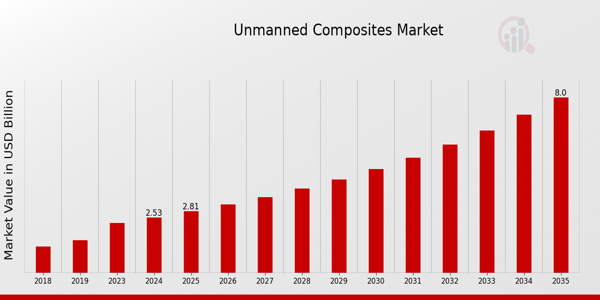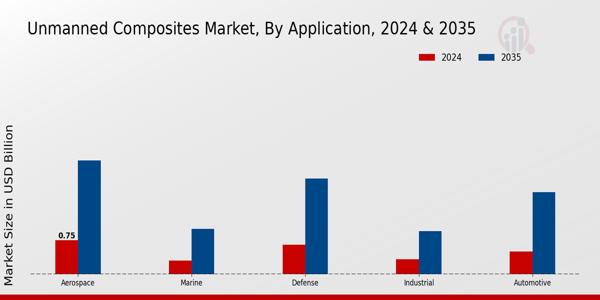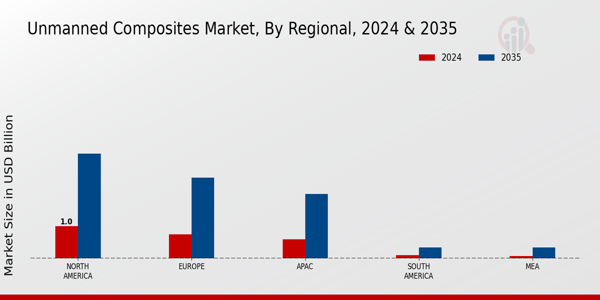Unmanned Composites Market Overview
The Unmanned Composites Market Size was estimated at 2.28 (USD Billion) in 2023. The Unmanned Composites Industry is expected to grow from 2.53(USD Billion) in 2024 to 8 (USD Billion) by 2035. The Unmanned Composites Market CAGR (growth rate) is expected to be around 11.03% during the forecast period (2025 - 2035).
Key Unmanned Composites Market Trends Highlighted
The Global Unmanned Composites Market is witnessing notable developments with trends such as the need for lightweight composites in drones and aerospace. The demand of manufacturers for advanced fuel efficiency along with enhanced performance is propelling the use of new composite materials. The need to address unmanned aerial vehicle (UAV) surveillance and delivery systems is focusing investment into unmanned technologies, creating strong demand for composites materials with unique durability and strength features. Supporting factors include the growth in the use of UAVs for commercial and defense applications, as well as worldwide UAVs.
Incorporation of smart devices like sensors and AI improves the efficiency of unmanned systems, expanding opportunities in the market. Custom developed materials that can operate in extreme environmental conditions pose a new opportunity for competitive advantage in the market. Moreover, countries across the globe are adopting new policies and regulations to support the development of unmanned technology, unlocking new opportunities for investment in the market. Construction of supporting infrastructure for operational UAVs along with the growing interest in environmental aspects is expected to considerably alter the dynamics of the market.
Recently, there has been an increase in the R&D activities related to bio-based composite materials, which aligns with the sustainability goals of the world. With the growing concern for the environment, manufacturers seem to be actively pursuing the promise of recyclable composites that could provide new opportunities in business. These tendencies are indicative of the increasing sustainable practices within the industry, demonstrating the global focus on developing environmentally friendly products. The synergy between technological innovations, legislation, and environmental concern is guiding the development of the Global Unmanned Composites Market towards more advanced and optimistic directions.

Source: Primary Research, Secondary Research, MRFR Database and Analyst Review
Unmanned Composites Market Drivers
Increasing Demand for Lightweight Materials in Aerospace Applications
The Global Unmanned Composites Market Industry is driven by the rising demand for lightweight materials, especially in the aerospace sector. The International Air Transport Association (IATA) has reported that airlines are increasingly focusing on fuel efficiency and reducing operational costs. Composites are crucial for achieving these goals, as they can reduce aircraft weight by up to 20%. Companies like Boeing and Airbus are investing in advanced composite materials for their latest aircraft designs, anticipating that composites will account for up to 50% of the structural weight of future aircraft.
With ongoing advancements in composite technologies, the demand for unmanned aerial vehicles (UAVs) using these materials is expected to significantly increase, contributing to market growth. Moreover, the growing trend towards sustainable practices in aviation assignments increased manufacturing efficiency by up to 30%, further propelling the Global Unmanned Composites Market.
Technological Advancements in Composite Manufacturing Processes
Technological advancements in manufacturing processes are another driver of the Global Unmanned Composites Market Industry. Innovations such as automated fiber placement and 3D printing of composites are being explored by leading organizations like Lockheed Martin and Northrop Grumman. These advances allow for enhanced precision, reduced waste, and lower costs in production, making it feasible to produce complex components that were not possible before.
Recent developments in additive manufacturing have shown up to a 40% reduction in material costs and a decrease in production times by 50%. This evolution not only means better profitability for manufacturers but also opens up new applications in various industries, from defense to civilian drones, thus fueling growth in the Global Unmanned Composites Market.
Rising Defense Spending and Unmanned Systems Adoption
The hike in defense spending across various countries is significantly propelling the Global Unmanned Composites Market Industry. According to the NATO report, defense spending among member countries increased by 2.1% in 2021, with significant investments directed towards unmanned systems. This shift reflects an increasing focus on modern warfare tactics, as unmanned aerial vehicles (UAVs) provide strategic advantages in intelligence, surveillance, and reconnaissance missions.
We see established defense contractors like Raytheon and General Atomics investing heavily in composite materials for UAVs, enhancing performance while reducing overall weight and cost. This increasing adoption of unmanned systems across both military and non-military applications is driving demand for advanced composite materials, further stimulating growth in the market.
Unmanned Composites Market Segment Insights:
Unmanned Composites Market Application Insights
The Global Unmanned Composites Market is poised for significant growth, with a valuation of 2.53 USD Billion expected in 2024, scaling up to 8.0 USD Billion by 2035. The Application segment plays a crucial role in this evolving market landscape, as it encompasses various industries such as Aerospace, Defense, Automotive, Marine, and Industrial, providing insights into their specific contributions and dynamics. The Aerospace sector, projected to be valued at 0.75 USD Billion in 2024 and reaching 2.5 USD Billion in 2035, holds a significant position as it demands lightweight and durable materials for aircraft structures and components, contributing largely to efficiency and performance enhancements.
The Defense market, valued at 0.65 USD Billion in 2024, expands to 2.1 USD Billion in 2035, reflecting a commitment to advanced materials that improve the capabilities of unmanned systems and platforms critical for national security. In the Automotive segment, expected to grow from 0.5 USD Billion in 2024 to 1.8 USD Billion in 2035, there is an increasing focus on utilizing composites to enhance vehicle safety, reduce weight, and improve fuel efficiency, aligning with global environmental sustainability goals. The Marine industry, estimated at 0.3 USD Billion in 2024 and anticipated to achieve 1.0 USD Billion in 2035, also demonstrates rising demand for composites that support the construction of lighter and more efficient vessels, appealing to both commercial and recreational markets.
Finally, the Industrial segment, witnessing a growth trajectory from 0.33 USD Billion in 2024 to 0.95 USD Billion in 2035, underscores the versatility of unmanned composites in applications such as robotics and automation, where performance and weight optimization are critical. As global trends steer toward automation and advanced manufacturing, the importance of the Application segment emphasizes the myriad possibilities when utilizing composites for enhanced operational efficiency and innovative designs across diverse industries, ultimately driving the overall market growth.
The various Application sectors not only reflect the current state of the Global Unmanned Composites Market but also signify a broader shift toward modern manufacturing methodologies that leverage advanced materials technology.

Source: Primary Research, Secondary Research, MRFR Database and Analyst Review
Unmanned Composites Market Material Type Insights
The Global Unmanned Composites Market, valued at 2.53 USD Billion in 2024, showcases significant growth within the Material Type segment, reflecting advancements in lightweight materials utilized in aerospace and defense applications. Key categories include Carbon Fiber Composites, known for their high strength-to-weight ratio, contributing to enhanced performance in unmanned aerial vehicles while reducing operational costs. Glass Fiber Composites play a crucial role, particularly in cost-sensitive applications, due to their excellent electrical and thermal insulating properties.
Aramid Fiber Composites offer exceptional durability and protection, making them ideal for military drones and other applications requiring resilience against harsh environments. Additionally, Thermoplastic Composites provide faster production cycles and recyclability, aligning with the growing demand for sustainable materials. The momentum in these material types is driven by the increasing need for advanced materials that enhance the performance and efficiency of unmanned systems, ensuring a strong foundation for the future of the Global Unmanned Composites Market revenue.
The evolving market trends surrounding these composites reflect their essential roles in innovation and the competitive landscape of the industry.
Unmanned Composites Market Manufacturing Process Insights
The Manufacturing Process segment within the Global Unmanned Composites Market is pivotal for the evolving landscape of composite materials. This segment, valued at 2.53 USD Billion in 2024, is being shaped by innovative manufacturing techniques such as the Lay-Up Process, which allows for customized shapes and designs, making it a favored choice for complex structures. The Resin Infusion method is gaining traction due to its efficiency and ability to produce lightweight, high-strength materials crucial for unmanned applications. Furthermore, Pultrusion stands out for mass production of consistent, high-quality composite profiles, while Prepreg Processing ensures optimal fiber orientation and resin content for superior performance.
The anticipated market growth signifies that these manufacturing processes are instrumental in driving advancements in the Global Unmanned Composites Market industry, influenced by increasing demand for lightweight and durable materials across various applications. Factors such as technological innovation and the push for sustainability are pivotal in fostering growth opportunities, while challenges such as high upfront costs remain significant. The sector is expected to evolve with continuous improvements, shaping the future of composite manufacturing on a global scale.
Unmanned Composites Market End Use Industry Insights
The Global Unmanned Composites Market is projected to reach a valuation of 2.53 USD Billion in 2024, reflecting significant growth in various end use industries. Among these, the Commercial Aviation sector plays a crucial role, driven by increasing demand for lightweight materials that enhance fuel efficiency and overall performance. The Military segment also showcases substantial growth due to the rising need for advanced, durable materials in unmanned aerial vehicles, which are essential for modern defense strategies. Furthermore, the Automotive industry is shifting towards the utilization of composite materials, focusing on weight reduction to improve efficiency and reduce emissions, while the Robotics sector continues to expand with applications that require high-strength, lightweight materials for various robotic forms.
The Global Unmanned Composites Market statistics reveal an expected shift in technological advancements and innovative applications, creating opportunities for manufacturers to develop specialized products that cater to these diverse sectors. Market growth is further stimulated by increasing investments in Research and Development, along with collaborations between industries to integrate composite materials into next-generation unmanned systems.
Unmanned Composites Market Regional Insights
The Global Unmanned Composites Market exhibits a strong regional dimension, with significant valuations projected across various regions. In 2024, the North America market is valued at 1.0 USD Billion, reflecting its dominance in the industry due to robust investments in defense and aerospace sectors. Europe follows with a valuation of 0.75 USD Billion, propelled by advancements in technology and increasing R initiatives. The Asia-Pacific (APAC) region stands at 0.6 USD Billion, showcasing a growing demand driven by urbanization and industrial applications.
South America, with a valuation of 0.1 USD Billion, and Middle East and Africa (MEA) at 0.08 USD Billion, represent emerging markets that are gradually recognizing the potential of unmanned composites, albeit from a smaller base. The significant majority held in North America highlights its strategic importance, while Europe’s growth is supported by expansive regulatory frameworks promoting innovation. APAC’s potential is further amplified due to its vast consumer base and technological uptake, encouraging regional industries to invest in unmanned composite solutions.
Overall, the Global Unmanned Composites Market displays diverse growth trajectories across these regional segments.

Source: Primary Research, Secondary Research, MRFR Database and Analyst Review
Unmanned Composites Market Key Players and Competitive Insights:
The Global Unmanned Composites Market has experienced considerable growth as technology and innovations continue to penetrate the aerospace, defense, and various commercial sectors. This market comprises a range of companies that leverage advanced composite materials to manufacture unmanned aerial vehicles (UAVs), drones, and other automation systems. The competitive landscape features organizations that not only focus on product development but also strive to enhance operational efficiencies, reduce costs, and improve sustainability. A significant trend observed in this sector is the increasing collaboration between companies and research institutions to propel advancements in composite materials. In addition, companies are increasingly investing in research and development to stay ahead of evolving customer demands and regulatory standards, all contributing to a dynamic and competitive marketplace defined by both established players and emerging entrants.
Textron has established a strong presence in the Global Unmanned Composites Market, leveraging its extensive background in innovative technologies and composite material applications. The company has built a reputation for producing high-performance unmanned systems that integrate advanced composites, enabling lightweight yet robust vehicle structures. Textron's diverse portfolio includes aircraft that are specifically designed for defense operations, allowing the company to effectively cater to the needs of its clientele. The company's strengths lie in its commitment to extensive research and development, streamlining production processes, and nurturing strategic partnerships. This enables Textron to maintain a competitive edge, ensuring that their unmanned systems meet and surpass industry standards while also accommodating potential advancements in technology.
Hensoldt has made significant strides in the Global Unmanned Composites Market, focusing on providing sophisticated sensor solutions and integrated systems that enhance situational awareness in unmanned vehicles. The company specializes in composite materials that optimize the performance and reliability of its products, which include cutting-edge surveillance and reconnaissance systems. Hensoldt's market presence is augmented by its relentless pursuit of innovation through strategic mergers and acquisitions that allow it to broaden its capabilities and access new technologies. Their strengths include a solid reputation for advanced intelligence solutions and a commitment to maintaining industry-leading quality standards. Furthermore, Hensoldt's active engagement in collaborations with other tech-centric firms fosters a robust ecosystem aimed at elevating the unmanned systems sector in the global arena, making it a well-respected player in the competitive landscape.
Key Companies in the Unmanned Composites Market Include:
- Textron
- Hensoldt
- BAE Systems
- Elbit Systems
- General Atomics
- Northrop Grumman
- AeroVironment
- Leonardo
- L3Harris Technologies
- Israel Aerospace Industries
- Lockheed Martin
- Kratos Defense and Security Solutions
- Raytheon Technologies
- Thales Group
- Saab
Unmanned Composites Market Industry Developments
Recent developments in the Global Unmanned Composites Market reveal a dynamic landscape with significant advancements and trends shaping the industry. Notably, in October 2023, Northrop Grumman announced the successful test of a new unmanned aerial vehicle that utilizes advanced composite materials enhancing performance and reducing weight. Meanwhile, BAE Systems has been expanding its Research and Development efforts focused on integrating advanced composites into next-generation unmanned systems. In terms of mergers and acquisitions, Lockheed Martin announced in January 2023 its acquisition of a small aerospace firm specializing in composite technologies, which is expected to enhance its capabilities in unmanned systems, supported by various mainstream news outlets. The market has experienced robust growth, spurred by increasing defense spending globally, with key players such as Elbit Systems and Raytheon Technologies reporting significant valuation increases due to enhancements in their unmanned systems portfolios. Moreover, in mid-2022, the collaboration between Leonardo and Israel Aerospace Industries to develop cutting-edge unmanned systems has significantly impacted the competitive landscape of the market, underscoring a continued trend towards composite material innovations in unmanned vehicle designs.
Unmanned Composites Market Segmentation Insights
Unmanned Composites Market Application Outlook
- Aerospace
- Defense
- Automotive
- Marine
- Industrial
Unmanned Composites Market Material Type Outlook
- Carbon Fiber Composites
- Glass Fiber Composites
- Aramid Fiber Composites
- Thermoplastic Composites
Unmanned Composites Market Manufacturing Process Outlook
- Lay-Up Process
- Resin Infusion
- Pultrusion
- Prepreg Processing
Unmanned Composites Market End Use Industry Outlook
- Commercial Aviation
- Military
- Automotive
- Robotics
Unmanned Composites Market Regional Outlook
- North America
- Europe
- South America
- Asia Pacific
- Middle East and Africa
|
Report Attribute/Metric
|
Details
|
|
Market Size 2023
|
2.28(USD Billion)
|
|
Market Size 2024
|
2.53(USD Billion)
|
|
Market Size 2035
|
8.0(USD Billion)
|
|
Compound Annual Growth Rate (CAGR)
|
11.03% (2025 - 2035)
|
|
Report Coverage
|
Revenue Forecast, Competitive Landscape, Growth Factors, and Trends
|
|
Base Year
|
2024
|
|
Market Forecast Period
|
2025 - 2035
|
|
Historical Data
|
2019 - 2024
|
|
Market Forecast Units
|
USD Billion
|
|
Key Companies Profiled
|
Textron, Hensoldt, BAE Systems, Elbit Systems, General Atomics, Northrop Grumman, AeroVironment, Leonardo, L3Harris Technologies, Israel Aerospace Industries, Lockheed Martin, Kratos Defense and Security Solutions, Raytheon Technologies, Thales Group, Saab
|
|
Segments Covered
|
Application, Material Type, Manufacturing Process, End Use Industry, Regional
|
|
Key Market Opportunities
|
Increased defense spending globally, Adoption in civilian drone applications, Advancements in composite manufacturing, Growing demand for lightweight materials, Integration of AI and automation
|
|
Key Market Dynamics
|
technological advancements, increasing defense spending, demand for surveillance applications, lightweight materials adoption, growing commercial drone sector
|
|
Countries Covered
|
North America, Europe, APAC, South America, MEA
|
Unmanned Composites Market Highlights:
Frequently Asked Questions (FAQ) :
The Global Unmanned Composites Market was valued at 2.53 USD billion in 2024.
By 2035, the Global Unmanned Composites Market is projected to reach a value of 8.0 USD billion.
The expected CAGR for the Global Unmanned Composites Market from 2025 to 2035 is 11.03%.
North America is expected to dominate the Global Unmanned Composites Market with a valuation of 3.25 USD billion by 2035.
The Aerospace application is expected to be valued at 0.75 USD billion in 2024 and grow to 2.5 USD billion by 2035.
The Defense application segment is projected to increase from 0.65 USD billion in 2024 to 2.1 USD billion by 2035.
Key players in the market include Textron, Hensoldt, BAE Systems, and Northrop Grumman.
The Automotive application segment is expected to reach 1.8 USD billion by 2035.
The Marine application is expected to be valued at 0.3 USD billion in 2024 and grow to 1.0 USD billion by 2035.
Emerging trends in technology advancements and increasing defense spending are expected to significantly drive market growth.

















